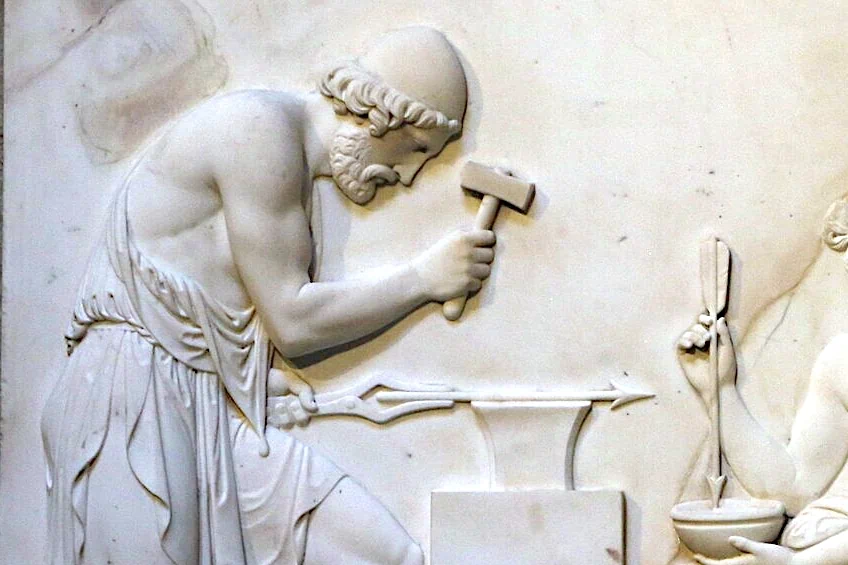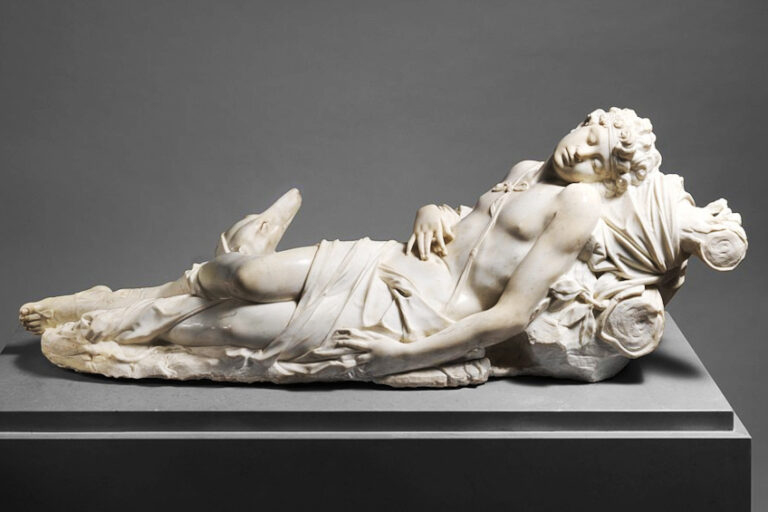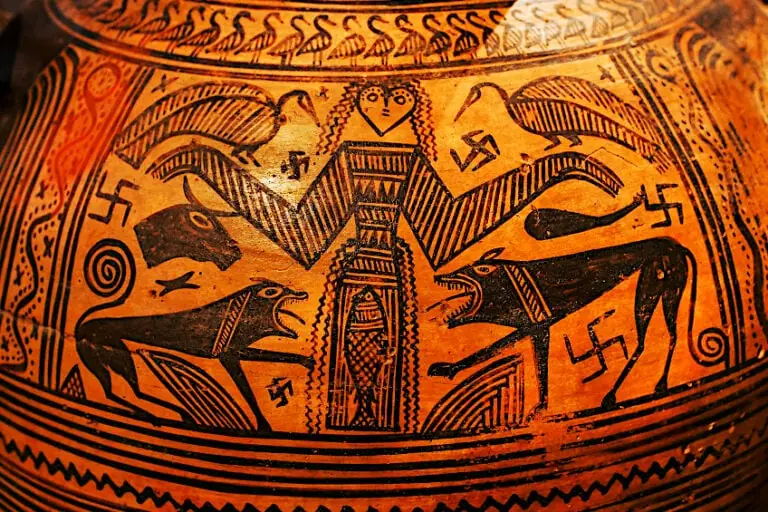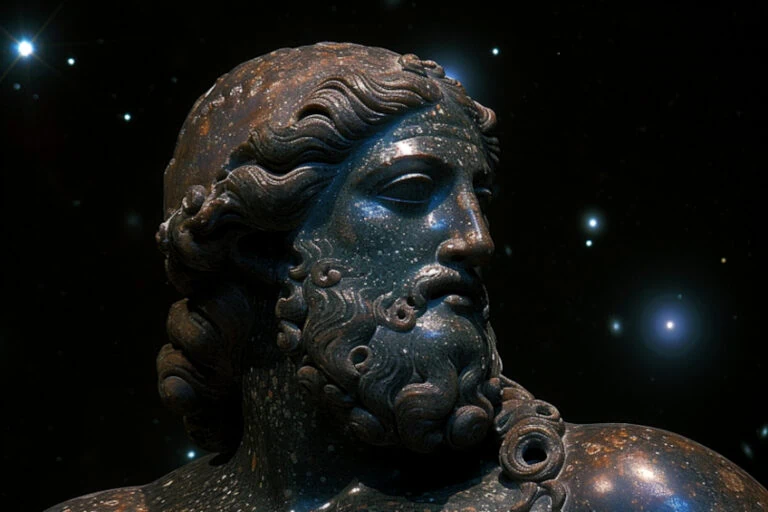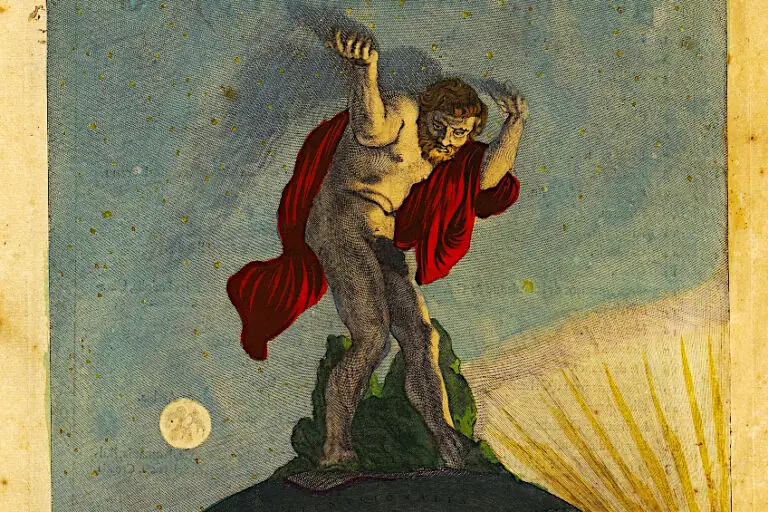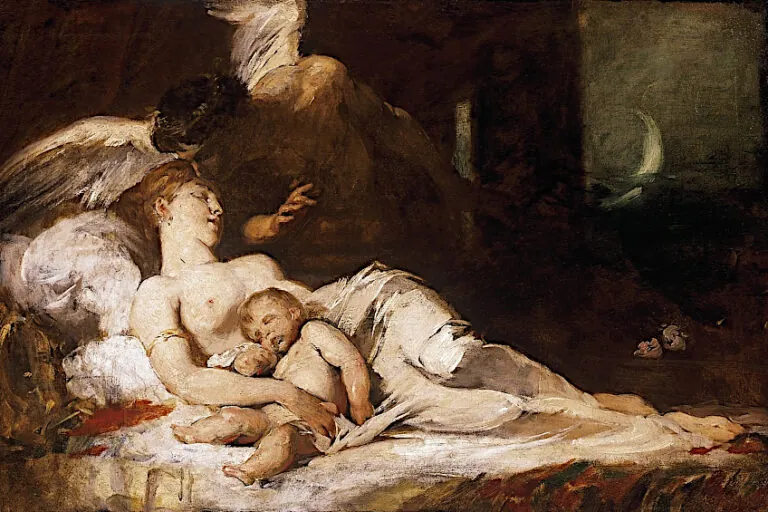Greek God Hephaestus – The Ingenious Olympian Craftsman
What is Hephaestus the god of and what is the Roman name of Hephaestus? In Roman mythology, Hephaestus is known as Vulcan, and in Greek mythology, he is the Greek god of fire, metalwork, craftsmen, carpenters, blacksmiths, and sculptors. As the god of blacksmithing, he also made all of the Olympian gods’ weapons. To find out more about the Greek god Hephaestus, keep on reading the article below!
The Mythology of the Greek God Hephaestus
| Name | Hephaestus |
| Gender | Male |
| God of | Fire, volcanoes, carpenters, blacksmiths, and craftsmen |
| Personality | Dedicated, meticulous, and talented |
| Symbols | Hammer and anvil |
| Consorts | Charis Aglaea and Aphrodite |
| Children | Eupheme, Eucleia, Euthenia, Philophrosyne, Erichthonius, Cabeiri, and Palici |
| Parents | Zeus and Hera |
The ancient Greek god of fire is undoubtedly the most unexpected member of the Olympian Pantheon. He is ugly, bearded, lame, and stocky and lacks the physical perfection of the other Olympians. He is sometimes represented wearing an oval cap with a hammer and an anvil.
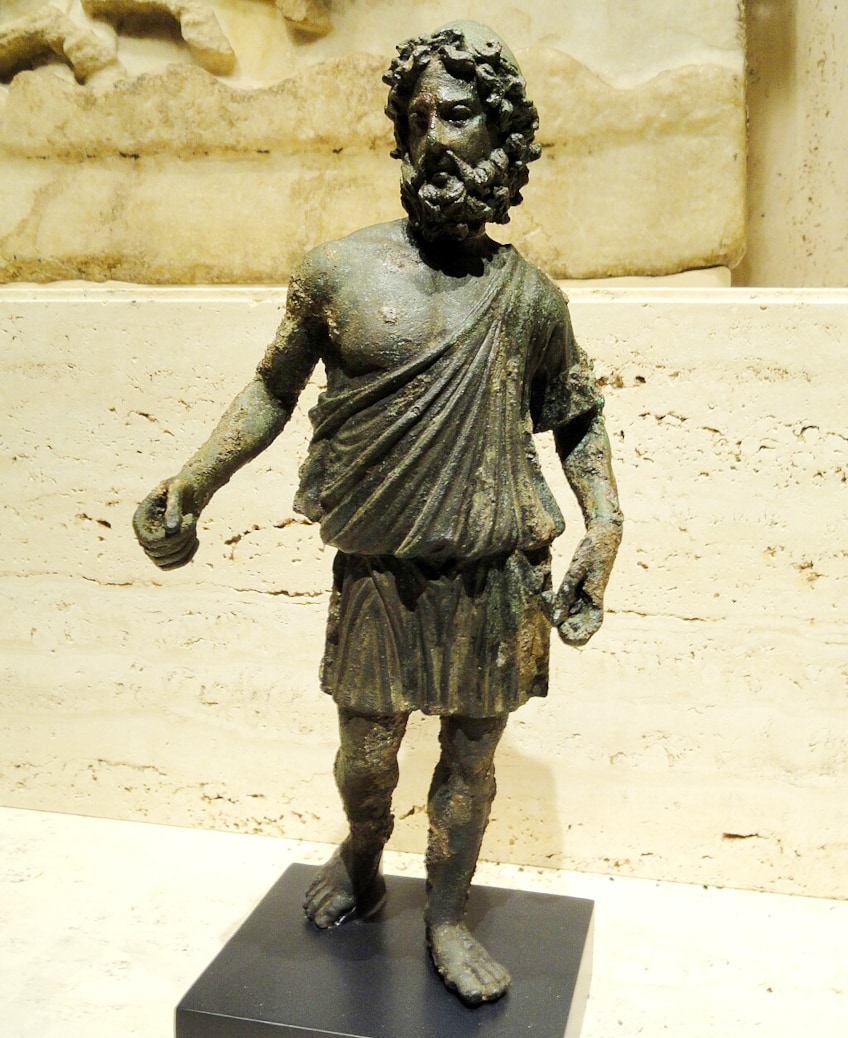 Roman copy of a Greek statuette of Hephaestus (1st or 2nd Century CE); Daderot, Public domain, via Wikimedia Commons
Roman copy of a Greek statuette of Hephaestus (1st or 2nd Century CE); Daderot, Public domain, via Wikimedia Commons
In the true spirit of the ancient Greeks’ love of irony, the lame god was not only the son of the king and queen of the gods, but also married to Aphrodite, the most desirable goddess of all. However, what he lacked in appearance, Hephaestus more than made up for in skill and ingenuity.
Background and Family of Hephaestus
On Olympus, Hephaestus had his own palace, complete with an anvil and 20 bellows that operated at his command. He was also believed to have workshops located inside the volcanoes that fell under his patronage.
Hephaestus was responsible for creating most of the beautiful gods’ equipment, and practically every finely produced piece of metalwork endowed with magic appearing in Greek mythology is believed to have been produced by Hephaestus.
Hermes’ sandals and winged helmet, the Aegis armor, Aphrodite’s famous girdle, the staff of Agamemnon, Helios’ chariot, the armor of Achilles, the bronze clappers of Heracles, and the bow and arrows of Eros were all designed by the Greek god Hephaestus.
 Roman relief showing Hephaestus and the Cyclopes forging the shield of Achilles as Athena and Thetis or Hera look on (date unknown); Capitoline Museums, Public domain, via Wikimedia Commons
Roman relief showing Hephaestus and the Cyclopes forging the shield of Achilles as Athena and Thetis or Hera look on (date unknown); Capitoline Museums, Public domain, via Wikimedia Commons
Parents of the Greek God Hephaestus
Hephaestus’ parents were Zeus and Hera according to Homer. Homer does not state if the Greek god Hephaestus was born with his deformities or if he became lame when his father threw him down to earth from Olympus after he intervened on his mother’s behalf during a dispute between her and Zeus. Hesiod, on the other hand, argues that Hephaestus is only Hera’s offspring and that she birthed him through parthenogenesis to retaliate against her husband, who had done the exact same thing to Athena.
 Zeus with Hera Expelling Hephaestus by Gaetano Gandolfi (between 1761 and 1769); Gaetano Gandolfi, Public domain, via Wikimedia Commons
Zeus with Hera Expelling Hephaestus by Gaetano Gandolfi (between 1761 and 1769); Gaetano Gandolfi, Public domain, via Wikimedia Commons
In one account of the myth, Hera, after bringing Hephaestus into the world, was so horrified by his appearance and embarrassed by his disability that she was actually the one who cast him out. Hephaestus suffered serious injuries in the fall, but he was saved by Eurynome and Thetis, who took care of him in a cave beneath the ocean for the following decade.
He plummeted for a full day and eventually landed on Lemnos island, where the Sintians – an ancient tribe of the island – cared for him and educated him so he could become a skilled craftsman.
The Greek God Hephaestus’ Return to Olympus
After being exiled, the Greek god Hephaestus was one of the few Olympians who ended up returning to Olympus. In an ancient narrative, Hephaestus exacted revenge on Hera for abandoning him by creating a magical golden throne that, once seated on, would not let her rise from it again.
The other gods pleaded for Hephaestus to return to Olympus and release her, but he refused.
Initially, Ares took on the mission of retrieving Hephaestus but had to defend himself against the torches flung by the Greek god of fire. Finally, the god of wine, Dionysus, got him drunk on wine, and returned the inebriated god to Olympus on the back of a donkey followed by revelers – an incident that may be seen on painted pottery from Corinth and Attica.
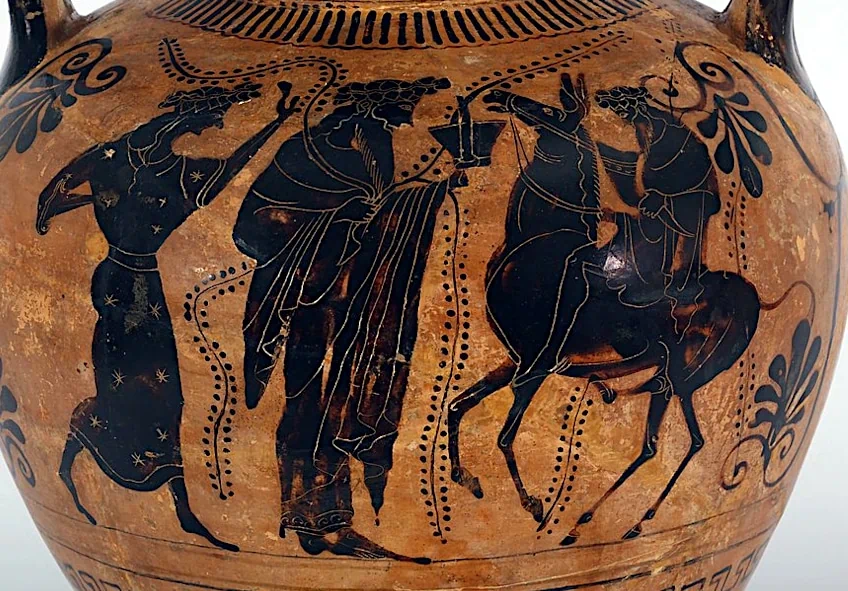 Black-figure amphora with a depiction of Dionysus and a Maenad encountering Hephaestus riding a donkey (c. 520 BCE); Walters Art Museum, Public domain, via Wikimedia Commons
Black-figure amphora with a depiction of Dionysus and a Maenad encountering Hephaestus riding a donkey (c. 520 BCE); Walters Art Museum, Public domain, via Wikimedia Commons
The phallic figures and the dancers of the Dionysian crowd escorting the donkey in the artwork indicate that the parade was part of the dithyrambic festivals that foreshadowed the satyr plays of 5th-century Athens. Zeus offered Hephaestus anything in order to rescue Hera, and he begged for Athena’s hand in marriage, which led to his attempted rape of her. In another account, he demanded to marry the Greek goddess of love, Aphrodite, in order to free Hera, and his mother granted him his wish.
The Personality and Physical Appearance of Hephaestus
Hephaestus is regarded as a talented and imaginative god. Hephaestus is usually depicted as a dedicated, tireless, and meticulous creator. He is respected for his intellect and problem-solving skills and is considered a master of technology and machines. Despite his talents and ingenuity, Hephaestus is also known as a lonely and reclusive god. Some myths portray him as disfigured, which adds to his sense of loneliness. The other Olympians and mortals, though, hold him in great regard for his knowledge and talents.
Hephaestus’ physical characteristics are often referred to as remarkably distinct. He is described as having a strong, stocky, and powerful physique in many tales, illustrating his association with hard work and craftsmanship.
His most notable feature in literature is his physical deformity. In most tales, Hephaestus is lame or walks with a pronounced limp, with either one or both of his legs impaired. He is also sometimes depicted with a scarred or disfigured face, which represents the tough conditions of the forge and the work he does with fire. According to some descriptions, he has a thick beard and untidy hair, which adds to his rugged and rough image.
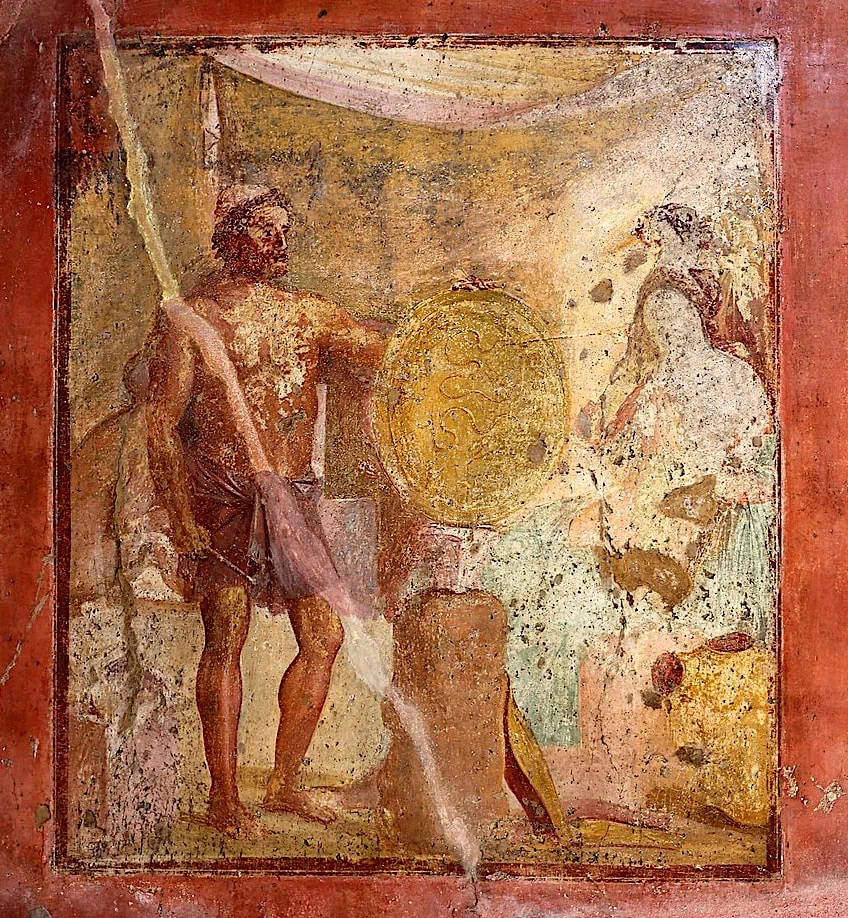 Fresco from Pompeii showing Vulcan/Hephaestus in his workshop (1st Century); Sailko, CC BY-SA 4.0, via Wikimedia Commons
Fresco from Pompeii showing Vulcan/Hephaestus in his workshop (1st Century); Sailko, CC BY-SA 4.0, via Wikimedia Commons
Some contemporary scholars have interpreted Hephaestus’ facial disfigurement and physical handicap as evidence of skin cancer and peripheral neuropathy caused by arsenicosis induced by arsenic exposure while metalworking. Arsenic was added to copper by Bronze Age blacksmiths to make tougher arsenical bronze, particularly throughout periods of tin shortage. As a consequence of their occupation, many Bronze Age blacksmiths would have been exposed to persistent arsenic poisoning. As a result, the fabled image of the handicapped smith has propagated.
Another possible reason for his deformity may lie in the suitability of blacksmithing as a profession for men who may have lacked the speed required for fighting or hunting, but have enough upper body strength to swing a heavy hammer for the duration of the day.
The Symbols of the Greek God of Fire
Hephaestus’ distinctive symbols are the hammer and anvil. They signify his position as the gods’ blacksmith. Hephaestus normally appears with a hammer, which he wields on the anvil in order to forge and mold metals.
Another symbol attributed to Hephaestus is the tongs. In blacksmithing, tongs are used to hold and manipulate hot metals.
He also often appears near flames or toiling in a blazing forge due to being the Greek god of fire. Fire symbolizes his knowledge of metallurgy and his skill at producing and manipulating metals through the use of fire. When the Titan Prometheus stole fire from Hephaestus’ forge to give to humans, Zeus instructed the fire-god to forge the unbreakable chains that would bind the thief to a rock where an eagle would eat his liver each day.
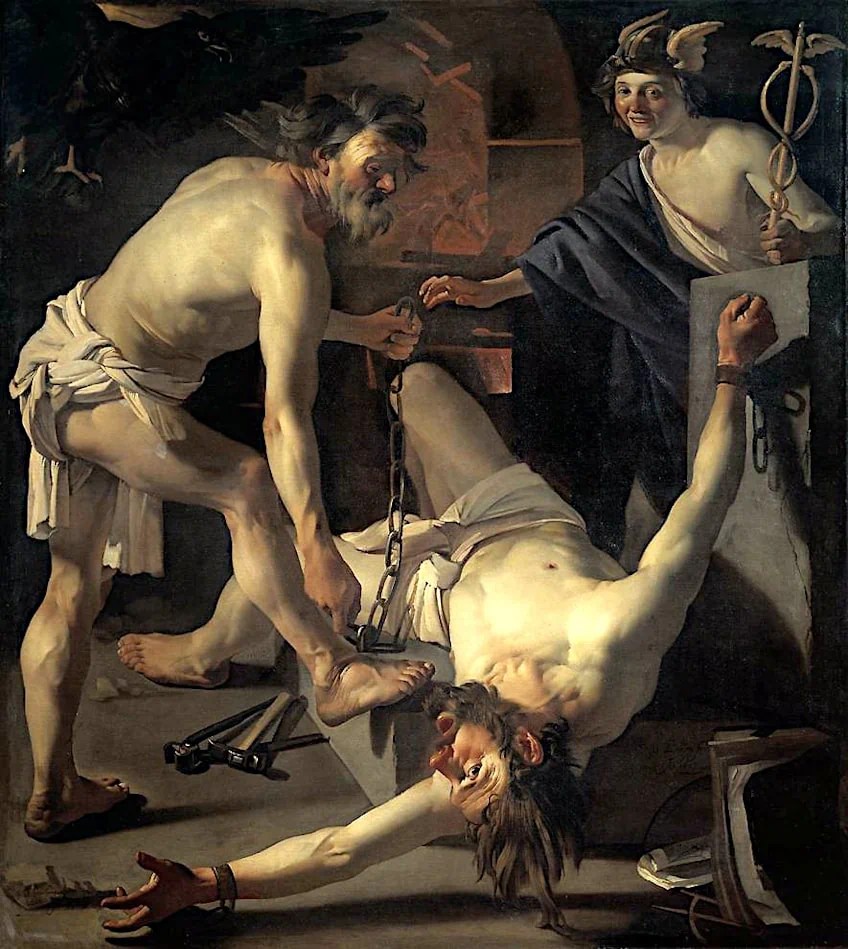 Prometheus Being Chained by Vulcan (Hephaestus) by Dirck van Baburen (1623); Dirck van Baburen, Public domain, via Wikimedia Commons
Prometheus Being Chained by Vulcan (Hephaestus) by Dirck van Baburen (1623); Dirck van Baburen, Public domain, via Wikimedia Commons
Volcanoes are often connected with the Greek god Hephaestus because they were said be his many forges. Volcanic eruptions were considered a symbol of his strength and creative intensity.
The Myths of the Greek God Hephaestus
In certain myths, Hephaestus constructed a “wheeled chair” to help him move around while also exhibiting his innovative abilities to the other deities. We have already covered the myths regarding his birth, expulsion from Olympia, and his subsequent return. Next, we will look at a few of the other most well-known myths associated with the Greek god Hephaestus.
Hephaestus and Aphrodite
Aphrodite had an affair with the god of war, Ares, while still being married to Hephaestus. The god of fire eventually heard about Aphrodite’s adultery through Helios, the sun who sees all, and devised a trap for one of their romantic moments.
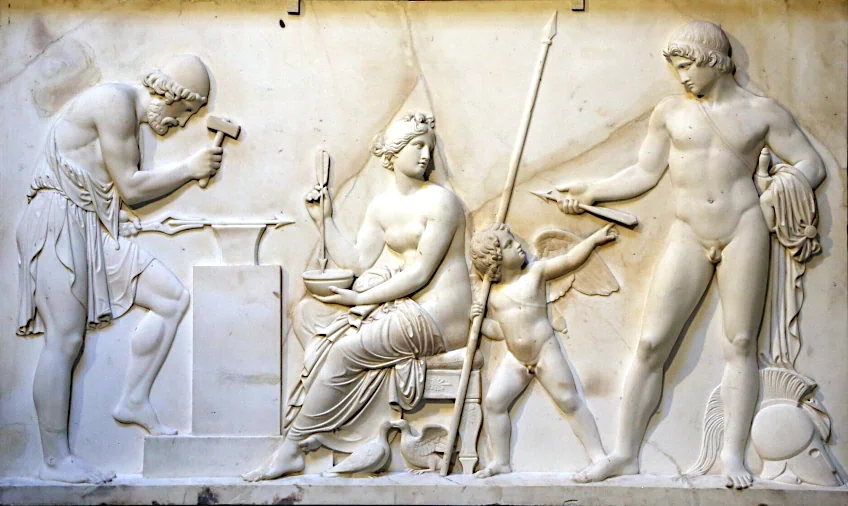 Mars (Ares), Venus (Aphrodite), and Vulcan (Hephaestus) by Bertel Thorvaldsen (1810). While her husband crafts her love-arrows, Aphrodite looks longingly at her lover standing behind her; Bertel Thorvaldsen, CC BY-SA 3.0, via Wikimedia Commons
Mars (Ares), Venus (Aphrodite), and Vulcan (Hephaestus) by Bertel Thorvaldsen (1810). While her husband crafts her love-arrows, Aphrodite looks longingly at her lover standing behind her; Bertel Thorvaldsen, CC BY-SA 3.0, via Wikimedia Commons
Hephaestus trapped the two lovers in a magical net and brought them up to Mount Olympus in order to shame them in the presence of the other Olympians as punishment. The Olympians all laughed at the naked lovers, and Poseidon convinced Hephaestus to release them in exchange for the promise that Ares would either pay the adulterer’s fine or he would pay it himself. Hephaestus declared he would bring Aphrodite to her father and demand his bride price back.
According to certain versions of the story, Zeus never returned the dowry, and Aphrodite merely manipulated her way back into her husband’s good books with her seductive ways.
Hephaestus and Athena
Hephaestus is said to be equivalent to the male deities what Athena is to the female since he imparts skills to mortals and was said to have taught males the arts alongside the goddess Athena. Temples and festivals were widespread in Athens. Both were thought to have extraordinary healing qualities, and Lemnian soil from the location where Hephaestus had fallen was thought to treat lunacy, snake bites, and bleeding; and priests of Hephaestus apparently knew how to cure snake bite wounds.
In Athens Hephaestus was not only a main feature of the city’s founding myth, but as the ultimate craftsman, he was also closely associated with Athena’s areas of influence.
The Greeks often erected tiny figurines of Hephaestus by their hearths, and these are the earliest representations of him. Hephaestus’ “soulmate” is at times believed to be Athena. Nonetheless, he wants to make love to her impulsively and passionately: at the climax, Athena pushes the god of fire aside, and his sperm falls to the soil, impregnating Gaia with Erichthonius.
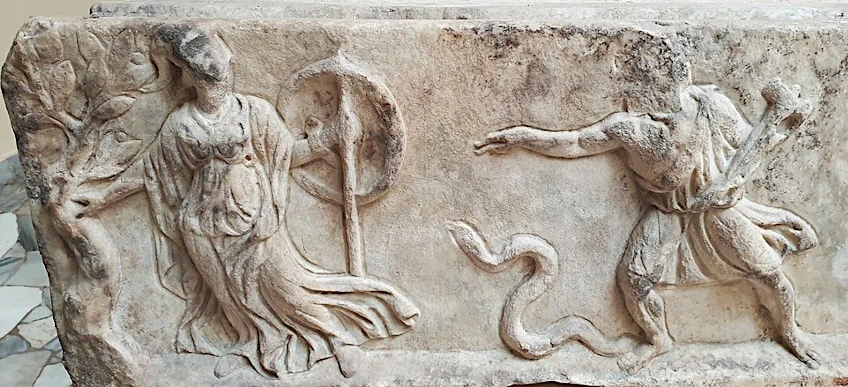 Relief depicting Athena fleeing the attentions of Hephaestus (2nd Century CE); MumblerJamie, CC BY-SA 2.0, via Wikimedia Commons
Relief depicting Athena fleeing the attentions of Hephaestus (2nd Century CE); MumblerJamie, CC BY-SA 2.0, via Wikimedia Commons
According to Hyginus, the Roman mythographer, in a slightly different version of the story, Hephaestus pleaded with Zeus to let him marry Athena because he was the one who cracked open Zeus’ head, enabling Athena to be born in the first place. Zeus eventually accepted his request, and Athena and Hephaestus were married; but, as he was about to complete the union, Athena fled from the wedding bed, forcing him to release his semen to the earth and impregnate Gaia with Erichthonius, who Athena then later adopted as her own.
Hephaestus and the Creation of Pandora
Zeus intended to punish both Prometheus and humankind when the Titan stole fire from the Olympian deities and handed it to humans. To accomplish this, Zeus concocted a plot to create a gift that despite its beautiful appearance, would bring suffering to humanity. Zeus commissioned Hephaestus, as the renowned blacksmith of the gods, to sculpt a beautiful woman who they named Pandora (many + gifts) from clay. Hephaestus meticulously crafted her form and bestowed upon her numerous talents both good and bad, donated by each of the gods.
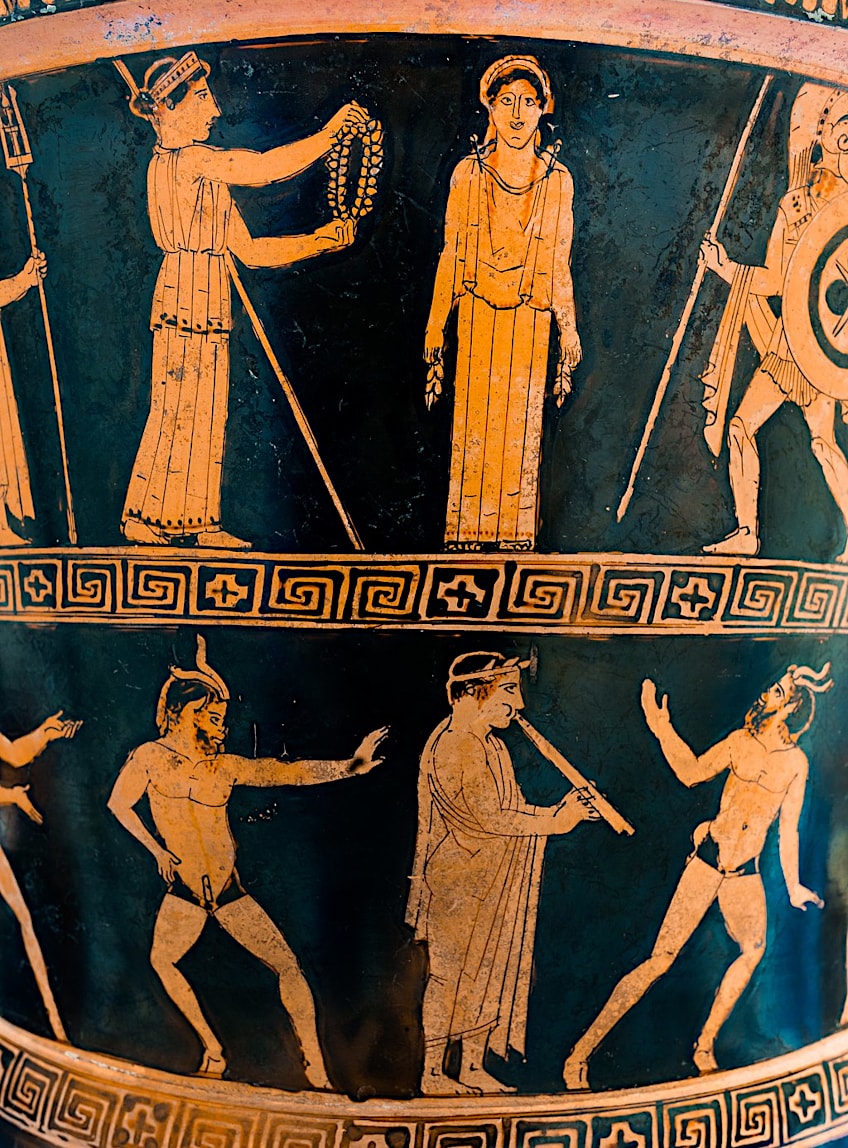 Attic red-figure calyx-krater with a depiction of the gods creating Pandora who is seen standing in the center of the upper row (c. 460-450 BCE); ArchaiOptix, CC BY-SA 4.0, via Wikimedia Commons
Attic red-figure calyx-krater with a depiction of the gods creating Pandora who is seen standing in the center of the upper row (c. 460-450 BCE); ArchaiOptix, CC BY-SA 4.0, via Wikimedia Commons
Zeus had a secret reason for creating Pandora. He gave her a jar as a present (which was misinterpreted to be a box in subsequent versions of the story), but he prohibited her from opening it, no matter what happened. Zeus, of course, knew Pandora’s insatiable curiosity would finally get the best of her. When Hephaestus had completed Pandora, Zeus then gave her to Prometheus’ brother, Epimetheus, as a bride.
Despite Prometheus’ cautions against receiving gifts from the gods, Epimetheus instantly fell in love with Pandora and married her.
Pandora carried the jar with her since she couldn’t resist her desire to discover its contents. Pandora’s curiosity became overwhelming over time, and she ultimately surrendered to the temptation. She unintentionally released a whole host of plagues, sicknesses, and all the disasters that would befall humanity by opening the jar. In her amazement and terror at the devastation that had been unleashed, Pandora quickly closed it, capturing one final thing inside, hope. The Pandora myth is used to explain why there is wickedness and misery in the world.
Hephaestus and the Creation of Achilles’ Armor
Achilles, the best warrior among the Greeks had withdrawn from the battle when he was forced to surrender a woman he had taken as a prize after destroying her city to King Agamemnon. Concerned for the fate of the Greeks who were now being pummeled by the Trojans, Achilles’ closest friend Patroclus entered battle disguised as the great hero by wearing his armor. However, Patroclus was killed in battle and the armor was stripped from his body by the triumphant Trojans.
Enraged with grief at his friend’s death, Achilles wanted to re-enter the war, but could not fight without armor. His mother Thetis, a sea nymph, went to visit Hephaestus at his forge on Mount Olympus and begged him to make a new set of arms fit for Achilles.
Moved by Thetis’ request Hephaestus agreed to make the armor for Achilles. He started by creating an exceptional shield. This shield was no average piece of armor; it was a work of art, intricately engraved with pictures of many facets of life and the universe. Hephaestus engraved pictures of towns, crops, vineyards, pastures, and even the skies into the shield. He created carvings of the sun, moon, and stars. The shield also contained scenes of violence, with soldiers engaged in combat, and a tranquil city under siege, which is meant to symbolize life’s contrasts.
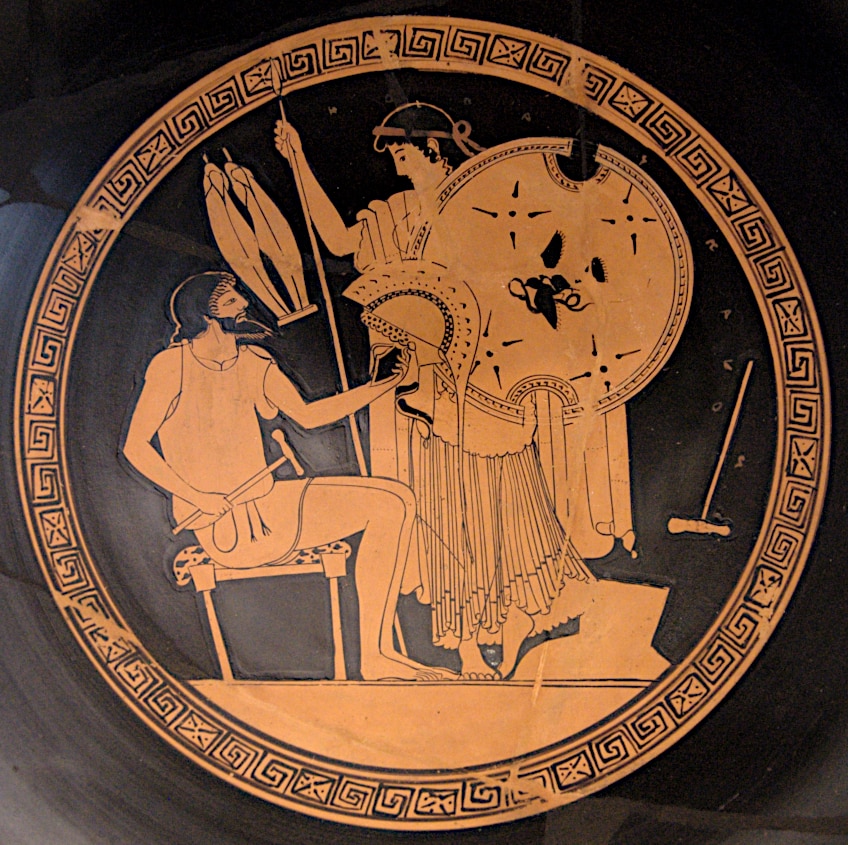 Attic red-figure kylix with a depiction of Hephaestus handing Thetis the armor he crafted for her son Achilles (490-480 BCE); Altes Museum, Public domain, via Wikimedia Commons
Attic red-figure kylix with a depiction of Hephaestus handing Thetis the armor he crafted for her son Achilles (490-480 BCE); Altes Museum, Public domain, via Wikimedia Commons
Hephaestus also fashioned heavenly armor for Achilles in addition to the shield. Achilles’ armor consisted of a shining bronze helmet, a strong and thick breastplate, and greaves to protect his legs. Hephaestus embellished the armor with complex motifs and ornaments to show off his outstanding workmanship. Hephaestus’ armor for Achilles was not only visually spectacular but also bestowed with magical qualities.
Hephaestus and the Automatons
Hephaestus built a collection of maidens dubbed the “Tripods”. These maidens were not ordinary individuals, but rather smart and self-moving automatons. Hephaestus created them to assist the gods on Mount Olympus with various duties. The Tripods were well-renowned for their outstanding workmanship and efficiency.
They had the power to deal with things independently and carry out the gods’ commands.
They had been described as elegant and gorgeous, completely built from gold, and resembling young maidens. Their particular functions and responsibilities varied according to which version of the myth you read, but they were usually associated with serving food and beverages at the gods’ divine feasts as well as maintaining the cleanliness and order of the halls of the gods.
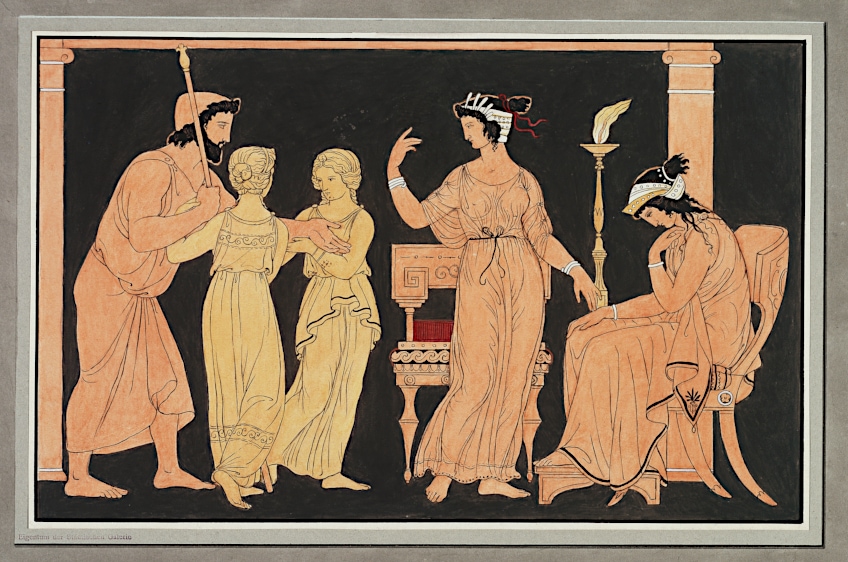 Thetis Commissioning Hephaestus to Make Armor for Achilles by Philipp Veit (c. 1832). The two golden automatons assist the god as he walks towards his seated client; Philipp Veit, PDM-owner, via Wikimedia Commons
Thetis Commissioning Hephaestus to Make Armor for Achilles by Philipp Veit (c. 1832). The two golden automatons assist the god as he walks towards his seated client; Philipp Veit, PDM-owner, via Wikimedia Commons
While the tale of the automaton maidens may not be as particularly well known as some other Hephaestus myths, it perfectly illustrates his extraordinary skill as a craftsman and his propensity for creating complex and smart things. The tale also illustrates ancient Greek society’s imagination in anticipating futuristic technology and automation.
The Lovers and Children of the Greek God of Fire
According to most accounts, Hephaestus’ partner is Aphrodite, who had an affair with an assortment of both deities and mortals, including Ares. In the Iliad, however, Charis – the most youthful of the Graces, as Hesiod refers to her – is Hephaestus’ consort.
“Charis” also means “the pleasure of art” and was an epithet applied to Aphrodite which Homer uses to describe Hephaestus’ wife in the Odyssey.
Periphetes, commonly known as “Club-Bearer,” is occasionally identified as Hephaestus’ son. He is portrayed as a criminal with a bronze club with which he robs and terrorizes travelers. Some accounts identify Palaimonius as Hephaestus’ son. He is linked to the ocean and is often portrayed as a sea god or merman. The Cabeiroi is a set of minor deities linked with metallurgy and handicraft. They are sometimes said to be the offspring of Hephaestus and the nymph Cabeiro, a daughter of Proteus.
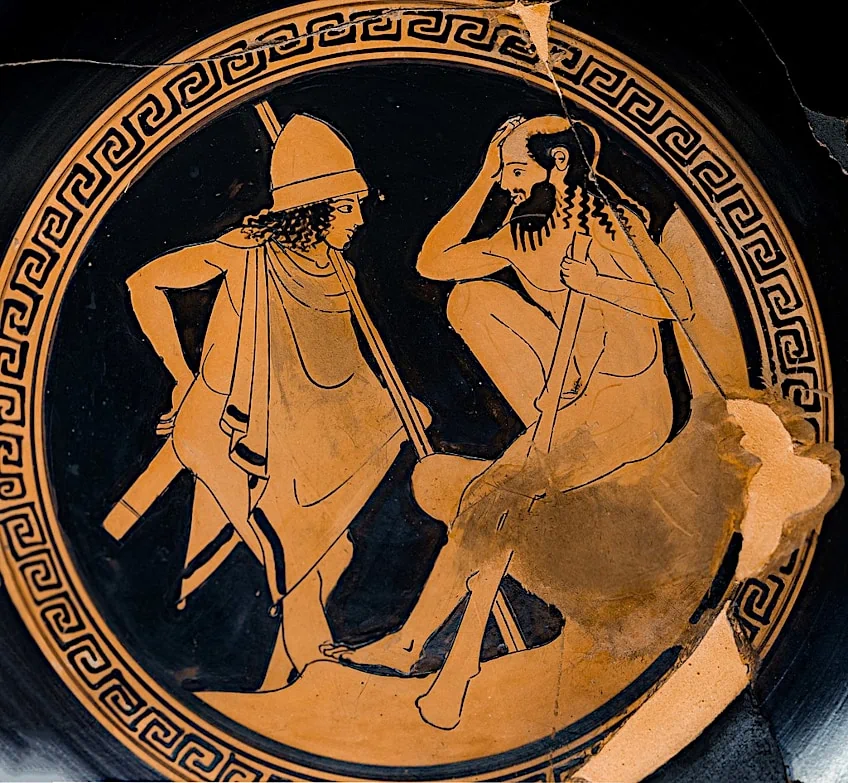 Attic red-figure kylix with a depiction of Theseus and Periphetes (c. 470-460 BCE); ArchaiOptix, CC BY-SA 4.0, via Wikimedia Commons
Attic red-figure kylix with a depiction of Theseus and Periphetes (c. 470-460 BCE); ArchaiOptix, CC BY-SA 4.0, via Wikimedia Commons
The Legacy of the Greek God Hephaestus
Hephaestus, the Greek god of fire, metallurgy, and craftsmanship, left a legacy that stays relevant in many different forms in this present period of time. While Greek mythology as a whole has enormous cultural and literary worth, Hephaestus in particular has had a long-lasting influence. Hephaestus represents the attributes of craftsmanship, talent, and innovation.
Because of his connection to metalworking and creation, he has become a lasting symbol of craftsmanship and human inventiveness.
His stories and persona continue to motivate blacksmiths and craftsmen, reminding them of the importance of skilled workmanship in a wide range of disciplines. The physical disfigurement that led to Hephaestus’ abandonment and expulsion resonates with issues regarding disability and perseverance. He personifies the notion that people with physical disabilities or impairments can overcome barriers and thrive in their chosen fields.
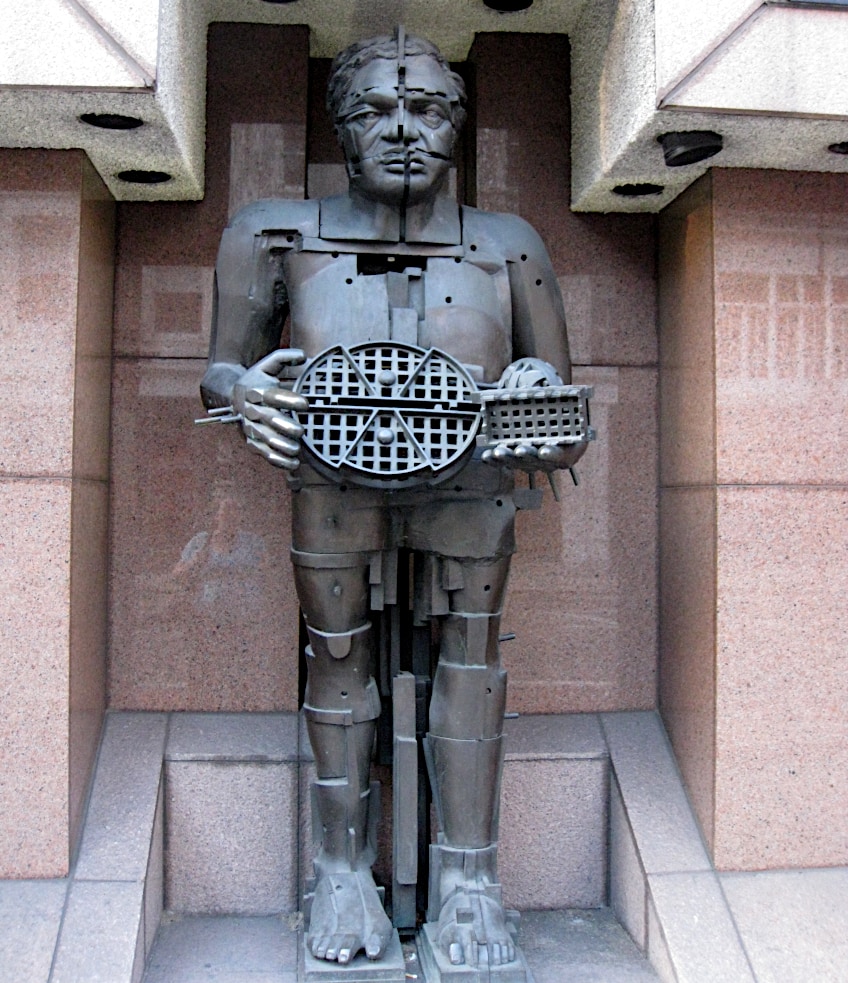 The Artist as Hephaestus by Eduardo Paolozzi (1987); Alf Melin, CC BY-SA 2.0, via Wikimedia Commons
The Artist as Hephaestus by Eduardo Paolozzi (1987); Alf Melin, CC BY-SA 2.0, via Wikimedia Commons
The story of Hephaestus has been regarded as a story of triumph over difficulties, bringing inspiration and hope to individuals suffering from hardships. The application of fire in metallurgy, as well as the creation of complex tools and equipment, could be viewed as a present-day expansion of Hephaestus’ domain of influence. As technology improves, Hephaestus’ legacy continues on via developments in metallurgy, engineering, and ingenuity.
While Hephaestus is by no means worshiped on the same level as many of the other gods, his legacy and symbols live on in artistic, cultural, and philosophical contexts. His experiences and characteristics provide insightful revelations into craftsmanship, human potential, and the quest for creativity. Despite being rejected by his family and suffering from disfigurement and disabilities, this incredibly strong and talented god became the creator of the gods’ weapons and objects of great value. He even married the most beautiful goddess of them all, Aphrodite.
Frequently Asked Questions
What Is Hephaestus the God of in Greek Mythology?
First and foremost, the Greek god Hephaestus is known as the god of fire and ruler of volcanoes. Yet, he is also known as the god of blacksmithing, metalwork, and other types of work that requires great skill while working with dangerous elements. He was so good at his job that he even made many valuable objects for the other gods. Because of his command of fire, he can shape and mold metal into many forms, making him the patron god of metalworkers, blacksmiths, and artists. Hephaestus is also associated with technology and automation, and even made robotic female robots out of gold!
What Is the Roman Name of Hephaestus?
Vulcan is the Roman counterpart of Hephaestus. Vulcan, like Hephaestus in Greek mythology, is the deity of fire, craftsmanship, and metalwork in Roman mythology. Many features of Greek mythology were absorbed by the Romans and integrated into their own pantheon, often providing Greek gods with new Roman names. As a result, in Roman mythology, the Greek God Hephaestus became the Roman god Vulcan.

I am deeply passionate about history and am constantly fascinated by the rich and complex stories of the past. As the editor-in-chief of learning-history.com, I have the opportunity to share this passion with a wide audience through the creation and distribution of engaging and informative content about historical events, persons, and cultures. Whether it’s through writing articles and blog posts or creating videos or podcasts, I strive to bring the past to life in a way that is both accurate and enjoyable. My expertise in history, combined with my strong writing and communication skills, allows me to effectively communicate complex historical concepts and make them accessible and interesting to a wide range of readers. I am truly grateful for the opportunity to share my love of history with others through my work on learning-history.com.

